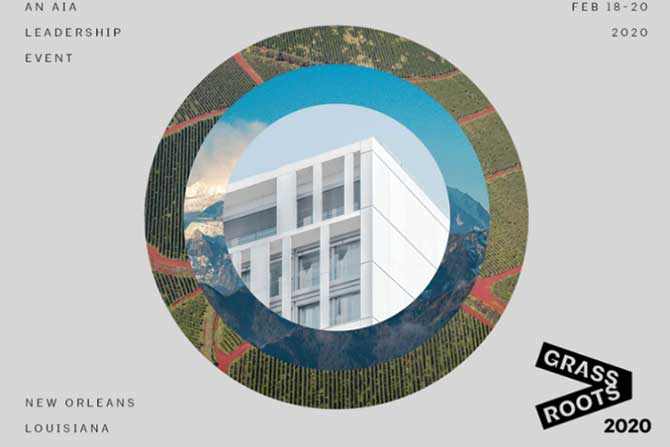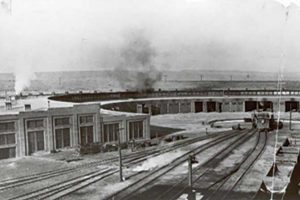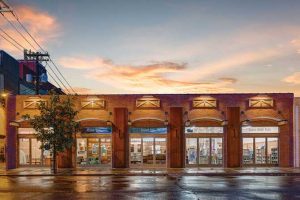By Clint Taylor, AIA and Susan Menghini, Executive Director
Grassroots 2020 is an exclusive event for leaders of the AIA. This year’s agenda emphasizes component and community leadership with workshops designed to help component officers become more effective chapter and civic leaders.
The event opened doors and provided opportunities for us to share knowledge, experiences, and challenges and network with your counterparts from around the country. Keynote speakers shared how both good design and leadership are fueling the success of communities and offering solutions to the most pressing needs facing cities.
We joined hundreds of other chapter leaders in New Orleans Feb. 18-20 for Grassroots 2020, AIA’s premier leadership training event for Chapters. We were able to share innovative approaches with our peers; explored smart, effective leadership strategies; learned how our peers are using the new AIA Framework for Design Excellence to address climate change; learned how to stimulate change in our chapter, firms and communities; and we networked and connected with our influential group of peers from around the country.
A complete listing of speakers included
the following:
Allison Dvorak, AIA,
Component President-elect,
AIA South Dakota
Amanda Harrell Seyburn, Assoc. AIA,
Component President,
AIA Mid-Michigan
Amy Blagriff, Hon. AIA,
Chief Operating Officer, AIA Colorado
Ann Casso, Hon. AIA,
Executive Director, AIA Trust
Bob Harris, CAE,
President and Founder,
Harris Management, Inc., Tallahassee
Brian J. Frickie, AIA,
AIA National Strategic Planning
Committee Chair
Chris Downey, AIA,
Component Member, AIA San Francisco
Chris Welty, AIA,
Immediate Past President, AIA Atlanta
Corey Clayborne, AIA, MBA,
Executive Vice President, AIA Virginia
Cynthia Williams, AIA,
Component President-elect, AIA Cincinnati
Dawn Taylor,
Component Executive Director,
AIA Kansas City
Gary Rifkin, CSP,
Chief Learning Officer, CoreClarity, Dallas
Greg Burke, FAIA,
Component Member, AIA Treasure Coast
Greg Verabian, AIA,
Component President,
AIA Los Angeles
Heather Gayle Holdridge, Assoc. AIA,
Component Member,
AIA San Antonio
Izzy Gesell, Alchemist, M.ED, CSP,
Organizational Alchemist,
Huntington, Massachusetts
Jason Winters, AIA,
Institute Secretary
Jeff Gill, FAIA,
Component Executive Director,
AIA Orange County
Joan Williams, Distinguished Professor and
Hastings Foundation Chair Director,
Center for WorkLife Law,
The University of California,
Hastings College of the Law, San Francisco
Jonathan Taylor, AIA,
Component President,
AIA Rhode Island
Karen Braitmayer, FAIA,
2019 AIA Whitney M. Young Jr. Award Recipient and Component Member, AIA Seattle
Kate Shelton,
Component Executive Director,
AIA Charlotte
Kathleen Gordon,
Component Executive Director,
AIA Baton Rouge
Kermit Baker, Ph.D.,
Chief Economist,
AIA National
Lindsey Ellerbach,
Component Executive Director,
AIA Eastern Oklahoma
Marc Mondor, AIA,
Component President,
AIA Pennsylvania
Matthew Lister,
Partner and Managing Director,
Gehl Institute, New York
Melissa Morancy, Assoc. AIA,
Director, Sustainable Knowledge
and Engagement, AIA National
Monica L. Wofford, CSP CEO,
Contagious Companies, Orlando
Rusty Bienvenue, Component Executive Director, AIA Houston
Santo Loporto, Sr. Director, Equitable
Sara Kay, Hon. AIA, Executive Director,
AIA Nebraska
Sarah F. Page, AIA, Component President,
AIA Chattanooga
Senator Tim Kearney, AIA,
Pennsylvania State Senate
Stephen Martin, Managing Director,
Professional Development and Resources,
AIA National
Tim Hawk, FAIA, Chair,
AIA National Government
Advocacy Committee
William J. Bates, FAIA, AIA 2019 President
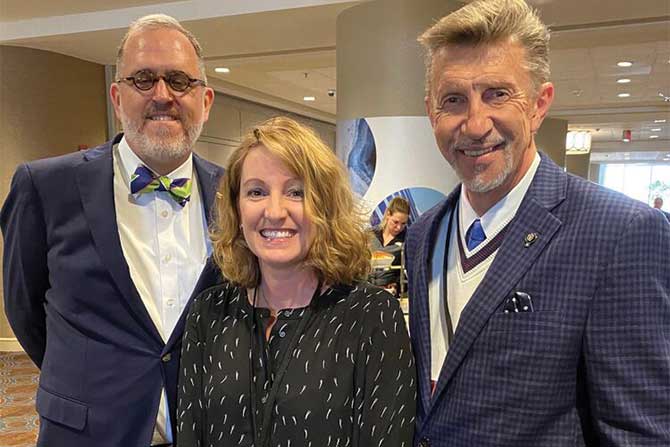
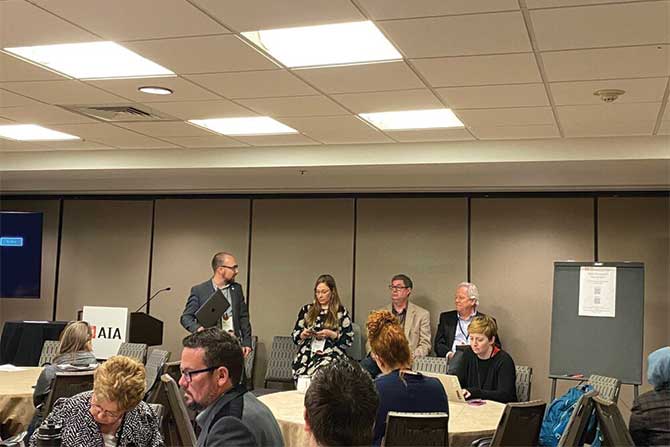
The deep-dive pre-conference sessions began Tuesday morning. The first session was provided by Joan Williams and was titled “Bias Interrupters in a Firm.” Bias interrupters are tweaks to basic business systems (hiring, performance evaluations, assignments, promotions, compensation, etc.) that interrupt implicit bias in the workplace, often without ever talking about bias. This workshop is designed to provide architects, design professionals, and firms with solutions to address specific profession biases based on the research completed by The Center for WorkLife Law.
Next were walking tours of the French Quarter, the oldest, most famous and most unpredictable neighborhood in New Orleans. The French Quarter — also called the Vieux Carré, or “old square” — is centered on Jackson Square, which St. Louis Cathedral overlooks, and the Three Squares, Three Cultures (Jackson Square, Congo Square and Lafayette Square), which are of profound historical importance. The history, culture and people influenced the buildings in this neighborhood. Although they are identical in size, each originated from and contributed to distinct historical cultures.
- Iconic Jackson Square, facing the Mississippi River, was founded by the French in 1718.
- Just beyond the original city boundary, Congo Square, founded in the early 19th century, is famous for its history of African American music and culture.
- Farther uptown across Canal St. Lafayette Square became the government seat for the 19th century American Sector.
The final tour was of the Albert and Tina Small Center for Collaborative Design. The Small Center, Tulane School of Architecture’s community design center, believes all residents should have a voice in shaping neighborhoods and communities. This tour showcased the center’s work across New Orleans, including design-build projects ranging from the city’s first official skatepark to shade structures and playscapes. The center’s design process supports capacity and coalition building on critical issues and collaborates with residents and nonprofits to strengthen neighborhoods and create a better future.
The Welcome Reception was held at Mardi Gras World. We experienced what it takes to bring Mardi Gras to life. Located along the 1400 Mississippi, the awesome venue gave us a flavor of the city. Towering columns, magical footbridges, magnificent oak trees and a starlit sky all add to the sense of wonder. We enjoyed delicious New Orleans food and entertainment as we networked with new and old friends.
Wednesday morning began with the opening general session and Mayors’ Panel on “Urban Resilience and Equity.” The panel consisted of:
- Kathy Ehley, the 16th Mayor of Wauwatosa, Wisconsin,
- Quinton Lucas, current Mayor of Kansas City, Missouri, and
- Wade Nomura, the Mayor of Carpinteria, California.
Following the Mayors’ Panel were breakout sessions about sharing our climate stories on the topics of energy, economy, or equitable communities. How are we dealing with the climate challenge in a meaningful way? What resources and tools are available as a pathway to healthier, more sustainable communities? We participated in an engaging and interactive session as the panelists shared their firm and component stories of how they are tackling climate change and care for their communities by becoming carbon neutral.
The afternoon sessions included the AIA Strategic Plan: Integrating Environmental Stewardship by Brian Frickie, AIA, an update of AIA’s strategic plan currently underway; Engaging with Mayor Matthew Lister and Senator Tim Kearney, AIA, discussion on how public life drives design, policy, and governance, cities thrive; Financial Responsibility and Risk Awareness by Bob Harris, CAE, a discussion on how sound financial management is essential to the effective operation of every organization; Leading Through Influence by Izzy Gesell, a discussion on building relationships and communicating ideas to others with credibility, confidence, and clarity; Speak Like a Pro by Gary Rifkin, CSP, a discussion on the ability to communicate with professionalism and passion is a requirement for today’s leader; Preparing for the AIA Annual Meeting by Jason Winters, AIA, Institute Secretary, covering everything you need to know before attending the annual meeting in 2020; AIA Continuing Education Services Program and Understanding HSW by Stephen Martin, a discussion on the AIA CES system.
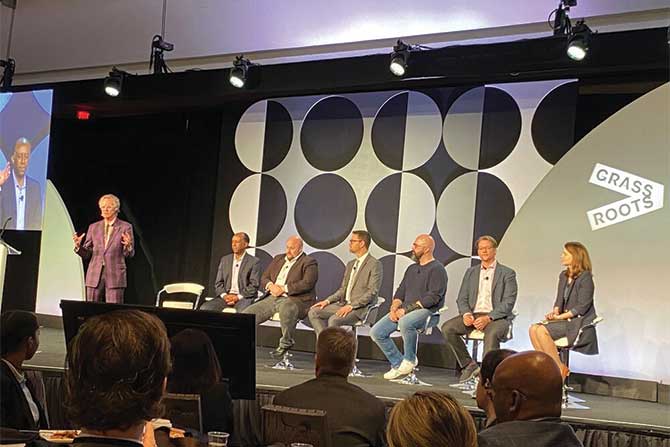
The day concluded with regional meetings. The Western Mountain Region gathered for their business meeting attended by Clint Taylor, AIA and Susan Menghini, ED. The six states covered the 2020 WMR elections and appointments, 2020 National elections, reports by the six states, shared best practices for The Big Move toward Environmental Stewardship. Following the business meeting was the WMR reception.
The following members have declared their intent to pursue the offices of 2021-2023 At-large Director, 2021-2022 Secretary, or 2021 First Vice President/2022 President-elect at the 2020 AIA Conference on Architecture: At-large Director — Jeffrey Ferweda, AIA, Ryan Gann, Assoc. AIA, Laura Lesniewski, AIA and Belinda Stewart, FAIA; Secretary — Edward Bernard, AIA, Brian Frickie, AIA and William Turner Jr., AIA; First Vice President/2022 President-elect Dan Hart, FAIA and Ed Vance, FAIA (shown above with Susan Menghini, ED).
Thursday, Susan began the day attending the AIA CACE Meeting and breakfast. The agenda covered an Institute update by Robert Ivy, FAIA, Big Move update by Abigail Gorman, Climate Action Plan by Lisa Richmond and Ben Prosky. Other updates included a Fonteva update by Becky Magdaleno, Regions Task Force update by Peter Kuttner, FAIA, and Component Relations update by Susan McDaid. Lastly, updates were provided on CACE in 2020 by Eric White, an AIA Trust update by Sara Kay and an Advocacy update by Sarah Dodge.
The morning sessions included Local Advocacy and Legislative Days at City Hall by Allison Dvorak, AIA, Greg Verabian, AIA and Tim Hawk, AIA, a session about Architects being called to be community leaders; Embracing our Differences moderated by William Bates, FAIA, a panel discussion on the central to our core values is the belief that the built environment should adapt to people rather than people having to adapt to the physical environment; Making Difficult People Disappear by Monica Wofford, CSP; Speak Like a Pro by Gary Rifkin, CSP, a discussion on the ability to communicate with professionalism and passion is a requirement for today’s leader; And the Winner Is panel discussion featuring award-winning programs from chapter executives and chapter leaders whose components received the Component EXCEL Programs and Best Practices grant; Succession Planning by Amy Balgriff, Cynthia Williams, AIA and Honathan Taylor AIA, a panel discussion on succession planning.
The final session comprised topics on The Design and Construction Outlook and Implications for Architecture, a presentation that touched on key trends in our economy and how they affect the construction industry in general and the architecture professions; Capital Campaigns and Investment Reserves by Chris Welty, AIA and Rusty Beinvenue, a discussion about several strategies available to increase revenues and financial security for any organization; How the AIA Trust Can Help You & Your Members, a discussion about the member-governed AIA Trust, how they support architects at every stage of their professional lives; Race and Gender in the Architecture Profession by Joan Williams.
The conference concluded with a closing keynote address by Michael Earl Cornett, Sr. a native of Oklahoma City, an American politician and former television personality who served as the 35th mayor of Oklahoma City from 2005 until 2018. He attended the University of Oklahoma earning a journalism degree in television news, followed by an MBA from the New York University specializing in management, entrepreneurship and leadership. He has been a proponent for urban issues/initiatives such as rapid and mass transit, economic diversification, urban renaissance, and civic beautification. The month Mr. Cornett left office, Oklahoma City was named the #1 city in the United States to start a business due to high marks in three different categories: Business Environment, Access to Resources and Business Costs. Mr. Cornett authored The Next American City. The book is described as “An invigorating look at how American cities are reinventing themselves and redirecting the future of the nation by way of civic engagement, inventive public policy, and smart urban design”.
Clint Taylor, AIA and Susan Menghini, Executive Director
This story appears in the 2020 Directory of the Wyoming Architecture Magazine.


